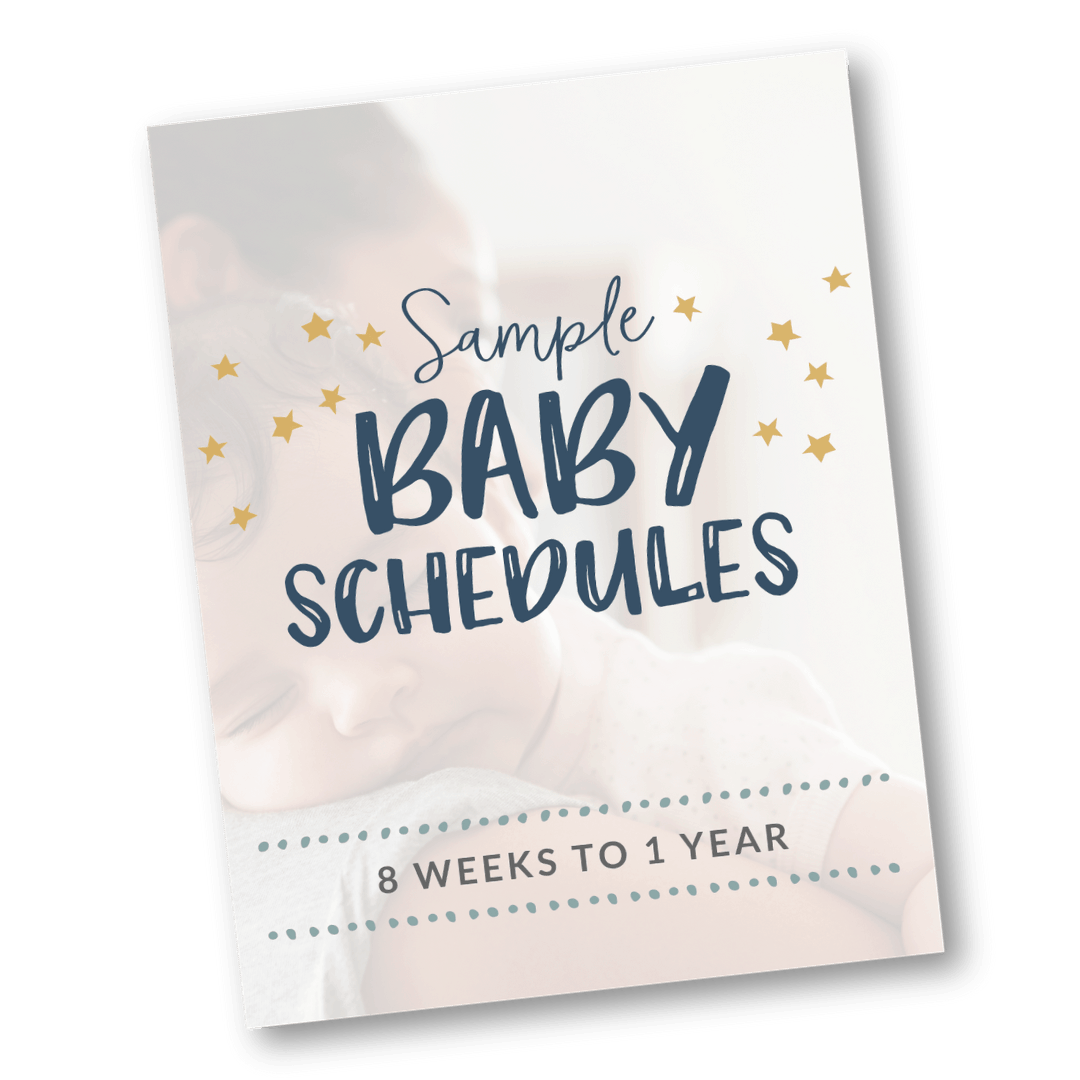
Using a 2 month old sleep schedule or a 3 month old sleep schedule is one of the best sleeping tips you can get.
Have you noticed something about your 5 to 11 week old? Something that makes getting your baby on a schedule seem like a great idea?
Your Little Prince has transformed into King Crankypants. It’s like he’s been bewitched!
Actually, in a way, he has.
Grumpy Babies are Normal at This Age
These weeks mark an important shift in your baby’s development. Your newborn’s magical ability to habituate and tune out extra stimulations has faded away, replaced with…nothing. The new self-soothing skills he needs haven’t developed yet.
He’s in limbo. Stuck between having his OFF button pushed automatically, and learning how to do it himself.
This leaves you with an important choice: Do you…
- Limp along and hope he figures it out eventually
- Guide your baby towards a better daily rhythm of sleeping and playing
Assuming you chose #2, here are some pointers to get you started. (If you chose #1, you might as well stop reading and check out what’s new on Netflix.)
What a 2 and 3 Month Old Sleep Schedule Is and Isn’t
In using the word “schedule,” I don’t mean rigid check-boxes with eating and sleeping appointments. At this age, those kinds of “schedules” generally bring more horror than harmony.
I’m talking about a good flexible schedule that will provide him with a predictably soothing daily list of events. This rhythm will teach you how to push the “off” button at the right times, and (hopefully) avoid an overtired, overstimulated, fussypants nightmare baby.
Your goals for your 2 and 3 month old sleep schedule should be simple. Here are the four things we want to focus on as we put your baby on a schedule.
- Learn the proper expectations you can have for sleeping and eating.
- Teach your infant the difference between day and night.
- Pencil out a rhythm, but be prepared to adjust it throughout the day.
- As often as possible, start trying to put your baby down sleep-y, but not sleeping.
Free Sleep Schedules
Baby on a Schedule Goal #1:
Set Healthy Expectations
Let’s take care of one thing right away. Every baby has a different “I can sleep through the night” timeline. At this age, most babies are going to still need to get up at least once or twice for feedings. They may manage a few 5-6 hours stretches (woo hoo!) but those 10-12 hour sleeping marathons are still several weeks away.
Besides that, if you’re breastfeeding, you don’t WANT your baby to go 10-12 hours without waking up to feed. You need those nighttime feeds to keep your milk supply high.
If you suspect that your baby is inching closer to 7-8 hours without waking up to feed (which can happen around 12 weeks), keep a 48 hour feeding log and then share it with your Lactation Professional and Pediatrician. They can then confirm whether your baby can stop getting nighttime calories or not.
Also, there’s a growth spurt between 6-8 weeks that will make your baby hungrier than usual. It’s very important that you feed your baby on demand during these times. He’s sending out a message that big changes and milestones are about to be reached and he needs more fuel than before!
Most doctors recommend you feed your baby on demand for the first 3-4 months, to make sure he’s getting the proper amount of calories he needs to grow healthy and strong. The kicker, is that sometimes babies aren’t actually hungry and so we end up feeding them when they aren’t, actually, demanding food.
That said, let me share some of the typical eating and sleeping patterns for infants this age. These are based on the average healthy, non-premature, baby. Use these guidelines as you try to put your baby on a schedule during the day.
2 Month Old Sleep Schedule Sample That’s Reasonable
I hesitate to list these, because I don’t want you to take them as solid-gold truth. Your baby is an individual. It is VITALLY important that you use his cues and patterns to help you learn where he fits on the “standard” scale.
So read this list with a grain of salt! ALWAYS run this by your doctor, the two of you (you and your doctor) are the experts on your baby! Not even a Certified Gentle Sleep Coach like myself knows your baby as well as you do!
Babies 5-to-8 weeks old generally sleep about 15.5 – 17 hours every day. A typical 2 month old sleep schedule looks like this:
- 8-10 hours of sleep a night (interrupted by multiple nighttime feedings)
- 6-7 hours of sleep during the day (divided into 4-5 naps)
A breastfed baby will typically still be eating every 2 .5-3 hours. It’s normal at this age for a baby to have 8-12 feedings in a 24-hour period. Formula fed babies usually polish off about 4 ounces every 3-4 hours.
REMEMBER! A high needs baby (colic, acid reflux, premature, etc.) will probably not fit ANY of these expectations! That’s okay, because he’s not feeling well. He’s a sick little guy and may need more feedings and cuddles than other babies. Just remember to keep good records, brush up on your soothing techniques, and be flexible.
A Reasonable 3 Month Old Sleep Schedule
Somewhere around the 9th week, you’ll see his “sleep time” begin to shrink. Instead of sleeping 17 hours a day, he starts sleeping only 15. The normal pattern for a 3 month old sleep schedule looks like this:
- 8.5 – 9 hours at night, usually interrupted with feeding sessions. (Bedtime is usually around 9pm…something that will move closer to 7pm as he gets older.)
- 5 hours of sleep during the day, split into three or four daytime “nap” periods
In regards to calorie consumption, a breastfed baby usually nurses every 2.5 to 3 hours at this age, while a formula fed infant can drink up to 4 – 5 ounces every 3-4 hours.
Scheduling Secret: Take Notes!
Like I said before, these are estimates! The only way to really know what your baby’s natural rhythms are is to write crap down. (Don’t try to remember anything. If you can’t remember the last time you showered, how are you going to remember how many ounces he drank last night at 2am?)
After you’ve taken notes for a few days, start looking for patterns by asking yourself…
- Can I see a rhythm in how often he is eating?
- Can I find a rhythm in how soon after he wakes up he’s ready to go down for a nap again? (Usually between 1 and 1.5 hours after waking.)
- Can I see a rhythm in how long he’s napping?
You want to uncover what your baby’s unique rhythms are, so you can know better what your expectations should be.
Baby on a Schedule Goal #2:
Teach “Night” and “Day”
Our second goal to work towards is to teach your infant between day and night. A good 2 month old sleep schedule will include lessons to help him learn the difference as quickly as possible.
- Whenever he is going to sleep, it is officially “night”.
- Whenever he is going to be awake and play, it is officially “day”
When you pick him up for the morning feeding, welcome him with a bright smile. Throw back the window shades, whistle a Mary Poppins duet with windowsill birds, or any other happy morning activities. (Don’t feel chipper? Fake it.)
You want him to associate “day” with a brightness, noise, and swift movements. Then, when you start seeing his sleepy cues for a nap (usually around 1 to 1.5 hours later), shut the shades, talk softly, sing quietly, and move slowly.
By doing these things, you’ll help his brain to start to notice that there’s a real difference between “bright playtime” and “dark sleeptime” as you transition to a 3 month old sleep schedule.
Btw, “dark sleeptime,” means pitch black. Either put sheets on the windows or grab some good travel blackout curtains. A dark room is a HUGE step in helping your baby be a champion sleeper! Don’t make the common sleep training mistake of having a cute nursery that’s utterly sleep dysfunctional. That room’s purpose is for SLEEPING. Forget that to your bleary-eyed peril.
Baby on a Schedule Goal #3:
Pencil Out a Daily Rhythm
Using the notes you’ve taken before, and my suggestions on what reasonable expectations are for your baby’s age, it’s time to pencil out a probably rhythm for your day. You should plan on doing this every day, since the exact times will vary daily.
Take the time he woke up, then write down an estimation of when you should start putting him down again. (Usually, for this age, the daily waketime window for naps is about 1 to 1.5 hours).
For example, if woke at 6:30am, then you should begin to see him get ready for nap around 7:30am. Then re-adjust the schedule every time he wakes. Never let him nap more than 6 hours during the day. You want his BEST sleep to be at night!
Free Sleep Schedules
Napping at This Age: It’s Not You. It’s Him.
Don’t get discouraged about napping. It’s going to be all over the map at this age. Some days he will be a rock star napper. Other days he’ll flatly refuse. Every day is going to look a bit different. You will have to adjust your rhythm every few hours to match his cues, or he will get overstimulated and have a meltdown. If that happens, do your best to get through the day and try to put your baby on a schedule again tomorrow.
Typically the crappiest nap at this age is the afternoon nap. Just try to squeeze out 30 minutes if you can. This means, don’t go to the crib unless he’s really screaming and it’s obvious to the world he’s not going to fall back asleep.
If that’s a stretch, sing, stroke his tummy, hold his hand…anything to try to extend the nap as long as possible. Sometimes it will work, sometimes it won’t.
- Try to wean him away from napping in swings in your 3 month old sleep schedule. Start him on a lower swing setting for each nap until it’s off, then transition him out of the swing entirely.
- “Napping on the go” will backfire on you at this age. Work hard to allow the first and second of the naps to occur at home, in a bassinet or crib. Those two will be the most critical.
- Even if you’re co-sleeping at night, have him nap in the bassinet or crib during the day to help him learn to fall asleep alone.
- The end of the 3rd month is the idea time to switch to the crib from the bassinet (if you haven’t already). If he hates this, start napping him in the crib the week before the move. If your baby just HATES sleeping in the crib, it’s time to put on your Sherlock hat and investigate.
Need An Extra Set of Certified Eyes?
If you’re struggling to find this rhythm, and he seems to be exhausted and overtired every day, you may want to consider signing up for a personalized Sleep Session with a Gentle Sleep Coach (GSC). You’ll fill out a health assessment, and then talk with me for an hour about the different shaping strategies and tweaks you can use at this age to help him get the rest he desperately needs.

Baby On a Schedule Goal #4:
Start Practicing “Sleepy But Not Sleeping”
One of the most important life skills your baby will need to learn in the first year is self-induced sleep. All humans go through sleep cycles that cause us to periodically wake up. As adults, our minds have been trained to put us right back to sleep. Usually.
Your baby’s brain hasn’t learned that skill yet. That’s why newborns require so much rocking, holding, singing, cuddling, to lull that brain. This is pretty easy when they’re newborns because they are naturally habituating.
Not so anymore! That magical sleep trick is fading away, and putting your baby on a schedule is the fastest way to help him replace it.
Provided that your baby doesn’t have any medical conditions like colic or reflux, you can teach him that skill without making him scream it out. The key is putting your baby in his crib when he’s good and sleepy, but not already sleeping. Understand?
So use one of these 62 different sleeping baby tricks to get him yawning and glassy-eyed. Then lay him down to finish the final journey to slumberland on his own. You won’t always get it right, somedays he’ll fall asleep too quickly. Somedays he’ll fight sleepiness altogether. Keep trying! Practice makes perfect! gradual sleep-happy improvements!
If he’s really struggling with this, try putting him down “sleepy but not sleeping” for the first nap of the day (or whichever nap he seems to find the easiest.) Then after 3-4 days, add the next nap, etc. etc. Oh, and this “Try Sleepy Not Sleeping” Rule doesn’t apply to those late night feedings! Let him snooze right through those.
A Few Final Sleeping Tips for Your 2 Month Old Sleeping Schedule
When it comes to getting your baby on a schedule that seems natural, here are some final tips:
- Avoid visitors or trips during the late afternoon and early evening hours. Usually the best time to run errands is in the morning, when your baby is more likely to sleep through them. (Test this to see if it applies to your baby.) Better yet, see if you can’t run the errands on the weekend or when someone is available to watch your baby.
- Make sure your baby’s tummy is being completely filled during feedings and he’s not snacking. 5-10 minutes snacks are not going to cut it. Understand his feeding personality and make adjustments.
- The Fussinator is especially strong in the 5-7 pm time range, right when work is over and Dad gets home. Encourage the working parent that this cranky baby is going through a growth change and is not sharing any “I don’t like Dad” feelings. He will plow through this season and be Dad’s number 1 fan again in no time.
We Love Citations!
Habituation in the Newborn. ScienceDirect.com
Typical Newborn Schedule. SleepLady.com
Babies and Brains: Habituation in Infant Cognition and Functional Neuroimaging. NIH.gov
Habituation: Studying Infants Before They Can Talk. Jove.com
We ♥ honesty! This post contains affiliate links that provide extra money for our mutual coffee habits addictions. Click here to learn more. As an Amazon Associate I earn from qualifying purchases.





